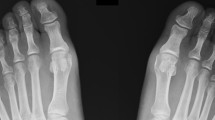Summary
Congenital triangular deformity of the foot bones may occur in phalanges and metatarsals. As it resembles the Greek letter Δ it is called “delta phalanx” and “delta metatarsal”. We report on 19 delta formations in ten patients with foot polydactyly. Our long-term follow-up of these patients indicates four stages in the ossification process: no ossification of the epiphysis; appearance of single or multiple ossification centers; unification of the ossification centers with nonosseous tissue between the diaphysis and the epiphysis; and, finally, complete ossification. Pathogenetically, the delta formation may represent an intermediate stage in the bifurcation process of a polydactylic ray. Splitting longitudinally in a direction from distal to proximal, it is the root of the bifurcated toe ray.
Zusammenfassung
In polydaktylen Füßen können „Rohrenknochen” als dreieckige Fehlbildungen auftreten. Da these Anomalien dem griechischen Buchstaben Δ ähneln, werden she Deltaphalanx oder Deltametatarsale genannt. Wir berichten über neunzehn solche Deltaformationen bei zehn Patienten mit polydaktylen Füßen. Die Beobachtung dieser Patienten vom ersten Lebensjahr his ins Erwachsenenalter läßt vier Entwicklungsstadien erkennen: Verknöcherung der Diaphyse ohne Ossifikation der Epiphyse; einzelne oder mehrere Ossifikationskerne der Epiphyse; Fusion dieser Epiphysenkerne mit Erhalt der knorpeligen Wachstumsfuge; knöcherne Kontinuität von Epiphyse and Diaphyse. Nach pathogenetischen Gesichtspunkten kann die Deltaformation ein Intermediärstadium im Gabelungsprozeß des polydaktylen Strahles darstellen. Da er sich von distal nach proximal teilt, kann die Deltaformation als Verzweigungsstelle des gedoppelten Zehenstrahls verstanden werden. Bei unseren Patienten waren der erste Zehenstrahl 13mal and der fünße 3mal betroffen. Bei einem Patienten waren der 1. and V. Zehenstrahl beider Füße befallen. Die Polydaktylie wurde nach ihrer Längsspaltung von distal nach proximal in einen distalen, mittleren and proximalen Phalanxtyp sowie einen metatarsalen and tarsalen Typ eingeteilt [2]. Bei unseren Patienten mit Deltaformationen im Fufßskelett fanden sich folgende Polydaktylieformen: Der distale und mittlere Phalanxtyp in jeweils einem Zehenstrahl, der proximale Phalanxtyp in sechs, der metatarsale Typ in neun and der tarsale in einem Strahl. Abgesehen von der Polydaktylie wurden andere angeborenen Anomalien bei sieben Patienten gesehen. Ein Erbgang war bei vier Patienten offenkundig. Diese Einteilung der Polydaktylie and der Verknöcherungsstadien von Deltaformationen sollen zum besseren Verständnis der Entwicklung von polydaktylen Füßen beitragen.
Similar content being viewed by others
References
Beyer L (1965) Polydaktylie an Hand und Fu\B — Vorkommen und ihre Behandlung. Inaugural-Dissertation, Medizinische Akademie “Carl Gustav Carus”, Dresden, p 41
Blauth W, Olason AT (1984) Polydactyly of the feet. Acta Orthop Scand 55:687
Carstam N, Theander G (1975) Surgical treatment of clinodactyly caused by longitudinally bracketed diaphysis (“delta phalanx”). Scand J Reconstr Surg 9:199–202
Gruber GB (1958) Hyperdaktylie (Polydaktylie), Diplocheirie und Diplopodie, Hypermelie, Oligodaktylie und Defekte von Röhrenknochen. In: Schwalbe E, Gruber GB (Hrsg) Die Morphologie der Mißbildungen des Menschen and der Tiere. Fischer, Jena, pp 720–808
Jäger M, Refior HJ (1971) The congenital triangular deformity of the tubular bones of hand and foot. Clin Orthop 81:139–150
Jones GB (1964) Delta phalanx. J Bone Joint Surg [Br] 46:226–228
Mestern J (1933) Hallux varus congenitus and Polydaktylie. Z Orthop 59:563–582
Müller W (1937) Die angeborenen Fehlbildungen der menschlichen Hand. Thieme, Leipzig
Olason AT (1986) Zur Klassifikation and Morphologie von Polydaktylien der Füße. Inaugural-Dissertation, Christian-Albrechts-Universität zu Kiel
Pfitzner W (1898) Beiträge zur Kenntnis der Mißbildungen des menschlichen Extremitätenskeletts. Schwalbes Morphol Arb 8:304–340
Theander G, Carstam N (1974) Longitudinally bracketed diaphysis. Ann Radiol 17:355–360
Venn-Watson EA (1976) Problems in polydactyly of the foot. Orthop Clin North Am 7:909–927
Watson HK, Boyes JH (1967) Congenital angular deformity of the digits. J Bone Joint Surg [Am] 49:333–338
Author information
Authors and Affiliations
Rights and permissions
About this article
Cite this article
Olason, A.T., Dohler, J.R. Delta formation in foot polydactyly. Arch. Orth. Traum. Surg. 107, 348–353 (1988). https://doi.org/10.1007/BF00381060
Received:
Issue Date:
DOI: https://doi.org/10.1007/BF00381060




